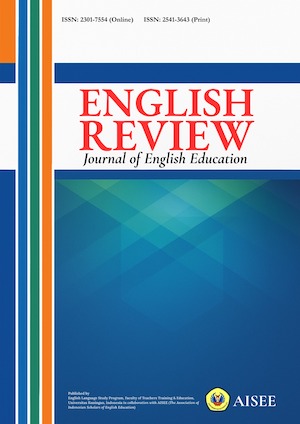PRESUPPOSITION ANALYSIS IN SOME SELECTED CONSUMER ADVERTISEMENT SLOGANS OF THE JAKARTA POST
Abstract
This research investigates the presupposition in the slogans of consumer advertisement of the Jakarta Post newspaper on March 2016 edition. This research aimed at finding the types of presupposition and describing the functions of presupposition in advertisement found in consumer advertisement slogans of the Jakarta post newspaper. Yule’s theory and descriptive qualitative research method applied in this research. 20 slogans of consumer advertisement of the Jakarta Post newspaper on March 2016 edition selected to this research. The result of this research showed that the writer found 20 presuppositions. 11 existential presupposition or 55%, 4 factive presupposition or 20%, 3 lexical presupposition or 15%, and 2 non-factual presupposition or 10%. Regarding the function of presupposition in advertisement, the writer found 17 slogans advertisement contains implicit competition, and 11 slogans advertisement contains making the advertisement short and memorable. In conclusion, not all type of presupposition and function of presupposition in advertisement are found, it is influenced by various types and functions in advertisement causing different assumption and presupposition. The writer hopes that further researchers who are interested in observing presupposition to explore more about presupposition in other types of advertisement.
Keywords: presupposition, consumer, advertisement, sloganReferences
Batyrovna, B,A. (2014). Semantic and pragmatic presuppositions in advertising slogans. Life Science Journal, 11(4), 261-263. Retrieved from http://www.lifesciencesite.com
Bonyadi, A., & Samuel, M. (2011). Linguistic nature of presupposition in American and Persian newspaper editorials. International Journal of Linguistics, 3(1), 1-15. Retrieved from http://www.macrothink.org/journal/index.php/ijl/article/viewFile/55 4/pdf
Fraenkel, J. R., Wallen, N. E., & Hyun, H. A. (2012). How to design and evaluate research in education (8th ed.). New York, NY: The MCGraw-Hill Companies, Inc.
Griffin, R. W., & Ebert, R. J. (2007). Bisnis: Edisi kedelapan (S. Wardhani, Trans.). Jakarta, Indonesia: Erlangga. (Original work published 1996).
Hashim, S. S. M. (2009). Existential presupposition in religious Islamic text: pragmatic implicature. International Conference on Arts, Economics and Management, 57-61. Retrieved from http://icehm.org/upload/5289ED03 14011.pdf
Kurniawan, R. (2014). An analysis of presupposition in selected slogan of outdoor advertisements. University of Kuningan: Unpublished.
Lam, K, Y, C. (2009). What is useful about presupposition in advertisements and what does it reflect?: A sociolinguistic study of Hong Kong culture, LCOM Papers, 2009(2), 45–55. Retrieved from http://www.english.hku. hk/LCOM %20paper/LCOM%20papers%20new,% 20rev/2009%20vol2/4Carr ieLam. pdf
Oktoma, E., & Mardiyono, S. (2013). The analysis of presupposition in the short stories of Silvester Goridus Sukur. English Review: Journal of English Education, 2(1), 76-86.
Puspitasari, N. (2015). Presuppositions in mobile phone advertisements (Masters thesis, State Islamic University of Sunan Ampel, Surabaya). Retrieved from http://digilib.uinsby.ac.id/2976/
The University of Sydney Library. (2014). Your guide to APA 6th style referencing (K. Masters, Rev.). Retrieved, from https://www.library.usyd.edu.au/su bjects/download s/citation/APA% 20Complete 2012.pdf
Universal College of Learning. (2011). A beginner’s guide to the APA referencing style (6th ed.). Retrieved from https://repository.wi.edu.au/alfresco/d/d/ workspace/S pacesStore/b9ea99d1-7b37-4f7cb909e5d8e413632c/APA%20Referencing%20Guide 6th%20Edition2012.pdf
Yin, R. K. (2011). Qualitative research from start to finish. New York, NY: The Guilford.
Yingfang, W. (2007). Analysis of presupposition and its function in advertisement. Canadian Social Science, 3(4), 55-60. Retrieved from http://www.cscanada.net/inde x.php/css/article/view/j.css.19236697200 7030 4.012/438.
Yule, G. (1996). Pragmatics. Oxford, England: Oxford University Press.
Zare, J., Abbaspour, E., & Nia, R. M. (2012). Presupposition trigger-a comparative analysis of broadcast news discourse. International Journal of Linguistics, 4(3), 734-743. Retrieved from http://www.macrothink.org/ journal/index.php /ijl/article/view/ 2002/pdf
All articles published in English Review: Journal of English Education (ERJEE) are licensed under the Creative Commons Attribution 4.0 International License (CC BY 4.0).
Copyright Ownership
Authors retain the copyright of their articles and grant ERJEE the right of first publication. The journal is granted a non-exclusive license to publish, reproduce, and distribute the article in any format, medium, or platform, provided that proper credit is given to the original authors.
License Terms – CC BY 4.0
Under the Creative Commons Attribution 4.0 International License, others are free to:
- Share — copy and redistribute the material in any medium or format
- Adapt — remix, transform, and build upon the material for any purpose, even commercially
As long as they:
- Provide appropriate credit to the original author(s) and source
- Provide a link to the license (https://creativecommons.org/licenses/by/4.0/)
- Indicate if any changes were made
There are no restrictions on the reuse, reproduction, or adaptation of published articles as long as attribution is properly given.
Author Warranties
By submitting a manuscript to ERJEE, authors confirm that:
- The work is original and does not infringe any existing copyright.
- The manuscript has not been previously published and is not under consideration elsewhere.
- All sources and references are appropriately acknowledged.
- Necessary permissions have been obtained for any copyrighted materials used.










